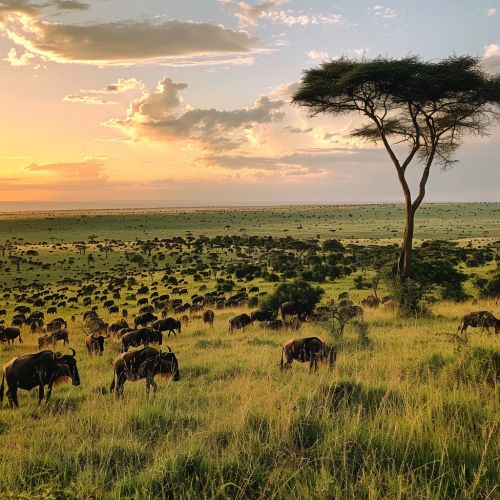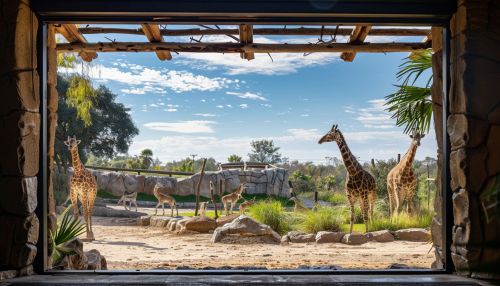Safari Zone
Introduction
The term "Safari Zone" refers to a specialized area within various ecosystems and recreational parks where visitors can observe and interact with wildlife in a controlled environment. These zones are designed to simulate natural habitats, providing a sanctuary for animals and an educational experience for humans. Safari Zones can be found in national parks, wildlife reserves, and even within certain amusement parks. This article delves into the intricacies of Safari Zones, exploring their history, design, management, and impact on both wildlife conservation and human education.
History of Safari Zones
The concept of Safari Zones can be traced back to the early 20th century when the idea of wildlife conservation began to gain prominence. Initially, these zones were established in Africa, where the term "safari" originated, meaning "journey" in Swahili. Early Safari Zones were primarily hunting grounds for the wealthy, but over time, the focus shifted towards conservation and education.
The first modern Safari Zone was established in the 1930s in Kruger National Park, South Africa. This park set the precedent for future Safari Zones by prioritizing the protection of wildlife and offering guided tours for educational purposes. The success of Kruger National Park inspired the creation of similar zones worldwide, including in North America, Europe, and Asia.
Design and Layout
Habitat Simulation
One of the critical aspects of Safari Zone design is the accurate simulation of natural habitats. This involves creating environments that closely mimic the animals' native ecosystems, including vegetation, water sources, and terrain. The goal is to provide a space where animals can exhibit natural behaviors, such as hunting, foraging, and socializing.


Enclosures and Barriers
While the primary aim is to create a naturalistic environment, safety is also a significant concern. Enclosures and barriers are designed to keep both animals and visitors safe. These can range from natural barriers like rivers and cliffs to man-made structures such as fences and glass walls. The design of these barriers is crucial; they must be unobtrusive to maintain the illusion of a natural habitat while being robust enough to ensure safety.
Visitor Experience
The visitor experience is another essential component of Safari Zone design. Paths and viewing platforms are strategically placed to offer optimal views of the animals without disturbing their natural behaviors. Many Safari Zones also include educational centers, interactive exhibits, and guided tours to enhance the learning experience.
Management and Operations
Conservation Efforts
Safari Zones play a vital role in wildlife conservation. They serve as sanctuaries for endangered species, providing a controlled environment where animals can live and breed safely. Many Safari Zones are involved in breeding programs aimed at increasing the population of endangered species. These programs often collaborate with other conservation organizations and research institutions.
Animal Care
The well-being of the animals is a top priority in Safari Zones. This involves regular health check-ups, a balanced diet, and ample space for exercise and social interactions. Veterinary teams are on-site to monitor the health of the animals and provide medical care when needed. Enrichment activities are also organized to keep the animals mentally and physically stimulated.
Staff and Training
Managing a Safari Zone requires a team of skilled professionals, including veterinarians, biologists, zookeepers, and educators. Staff members undergo rigorous training to ensure they are well-equipped to handle the complexities of animal care and visitor management. Continuous professional development is encouraged, with many staff members participating in workshops, conferences, and research projects.
Impact on Wildlife and Human Education
Conservation Success Stories
Safari Zones have been instrumental in the conservation of several endangered species. For example, the black rhinoceros population has seen a significant increase due to the efforts of Safari Zones in Africa. Similarly, breeding programs for the California condor in North American Safari Zones have helped bring the species back from the brink of extinction.
Educational Outreach
One of the primary goals of Safari Zones is to educate the public about wildlife and conservation. Educational programs are designed for visitors of all ages, from school children to adults. These programs often include guided tours, interactive exhibits, and workshops. By fostering a deeper understanding of wildlife and the importance of conservation, Safari Zones aim to inspire visitors to become advocates for the environment.
Economic and Social Impact
Safari Zones also have a significant economic and social impact. They create jobs, attract tourists, and generate revenue for local communities. Additionally, they often engage in community outreach programs, providing educational opportunities and supporting local conservation initiatives.
Challenges and Criticisms
Ethical Concerns
Despite their many benefits, Safari Zones are not without controversy. Ethical concerns have been raised about the captivity of animals and the potential for exploitation. Critics argue that no matter how well-designed a Safari Zone is, it cannot fully replicate the freedom and complexity of a wild habitat. These concerns have led to ongoing debates about the ethics of keeping animals in captivity for educational and conservation purposes.
Financial Sustainability
Running a Safari Zone is an expensive endeavor, requiring significant financial resources for maintenance, animal care, and staff salaries. Many Safari Zones rely on ticket sales, donations, and grants to fund their operations. Financial instability can jeopardize the quality of care provided to the animals and the overall visitor experience.
Environmental Impact
The construction and operation of Safari Zones can also have an environmental impact. Building infrastructure in natural areas can disrupt local ecosystems and wildlife. Additionally, the presence of large numbers of visitors can lead to pollution and habitat degradation. Safari Zones must implement sustainable practices to minimize their environmental footprint.
Future Directions
Technological Innovations
Advancements in technology are opening new possibilities for Safari Zones. Virtual reality (VR) and augmented reality (AR) are being explored as tools to enhance the visitor experience and provide more immersive educational opportunities. Additionally, technology is being used to monitor animal health and behavior more effectively, allowing for more precise and timely interventions.
Global Collaboration
Global collaboration is becoming increasingly important in the field of wildlife conservation. Safari Zones around the world are forming partnerships to share knowledge, resources, and best practices. These collaborations are essential for addressing global conservation challenges and ensuring the long-term survival of endangered species.
Community Involvement
Engaging local communities is crucial for the success of Safari Zones. By involving communities in conservation efforts and providing economic and educational opportunities, Safari Zones can foster a sense of ownership and responsibility towards wildlife conservation. Community involvement also helps to ensure that conservation initiatives are culturally sensitive and sustainable.
Conclusion
Safari Zones play a critical role in wildlife conservation and education. By providing a controlled environment where animals can thrive and visitors can learn, they bridge the gap between humans and the natural world. While challenges and criticisms exist, the benefits of Safari Zones in terms of conservation success stories, educational outreach, and economic impact are undeniable. As technology and global collaboration continue to advance, the future of Safari Zones looks promising, offering new opportunities for innovation and growth.
